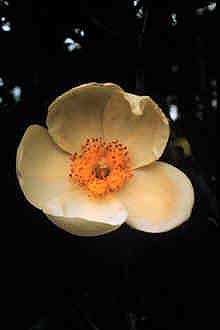Gordonia lasianthus
| Gordonia lasianthus | |
|---|---|
 |
|
| Gordonia lasianthus flower | |
| Scientific classification | |
| Kingdom: | Plantae |
| (unranked): | Angiosperms |
| (unranked): | Eudicots |
| (unranked): | Asterids |
| Order: | Ericales |
| Family: | Theaceae |
| Genus: | Gordonia |
| Species: | G. lasianthus |
| Binomial name | |
|
Gordonia lasianthus (L.) Ellis |
|
 |
|
| Natural range | |
Gordonia lasianthus (loblolly-bay, holly-bay, gordonia, or bay) is a small to medium-sized evergreen tree or shrub found in acid, swampy soils of pinelands and bays on the Atlantic and Gulf Coastal Plains of the southeastern United States. It is a member of the Tea or Theaceae family. It is slow growing with soft, light-colored(Varies in color from Cream to Carmine), fine-grained wood of little commercial value, although loblolly-bay could be managed as a source of pulpwood. When older specimens are cut, the wood exudes a strong scent. It is similar to a mixture of fresh oranges and pine sap. The bark of the adult tree varies from medium grey to a red brown coloration. Dead adult specimens of loblolly bay exhibit a lustorous shine when exposed to sunlight for several years. The white showy flowers and shiny foliage make it a desirable ornamental, but it is not easy to cultivate. Deer browse stump sprouts heavily.
Loblolly-bay is continuously distributed along the Atlantic and Gulf Coastal Plains from Coastal Southern Virginia to the Appalachicola River in the Florida Panhandle. Discontinuous populations exist in Florida, the coastal counties of Alabama, and southern Mississippi. In South Carolina it is commonly found in the lower Coastal Plain, but in the middle and upper Coastal Plain it is restricted to specific sites.
The climate over the range of loblolly-bay is characterized by mild winters and warm summers. Air temperature data, compiled from a weather atlas (8), are as follows:
The average annual precipitation within the range of loblolly-bay is 1630 mm (64 in) in Florida, declining to 1120 mm (44 in) in North Carolina, and is fairly evenly distributed throughout the year.
Approximately 53 percent of the annual precipitation occurs during the months of June, July, August, September, and October. Annually there are from 110 to 120 days with only a trace of rainfall.
In North and South Carolina, loblolly-bay is apparently very soil-specific even though it is found on several soil series. It grows on certain Spodosols, Inceptisols, Ultisols, and Histosols and to a lesser degree on Entisols and Mollisols (7). Soil profiles of a loblolly-bay site in South Carolina have the following general characteristics at various soil horizons:
Loblolly-bay grows in flat woodlands or shallow depressions with little or no slope, slow runoff, rapid permeability, and poor to very poor drainage. In South Carolina the soils are usually of sandy coastal plain or marine origin, except for the organic soils. The water table is at or near the soil surface for 6 to 9 months of the year.
...
Wikipedia
